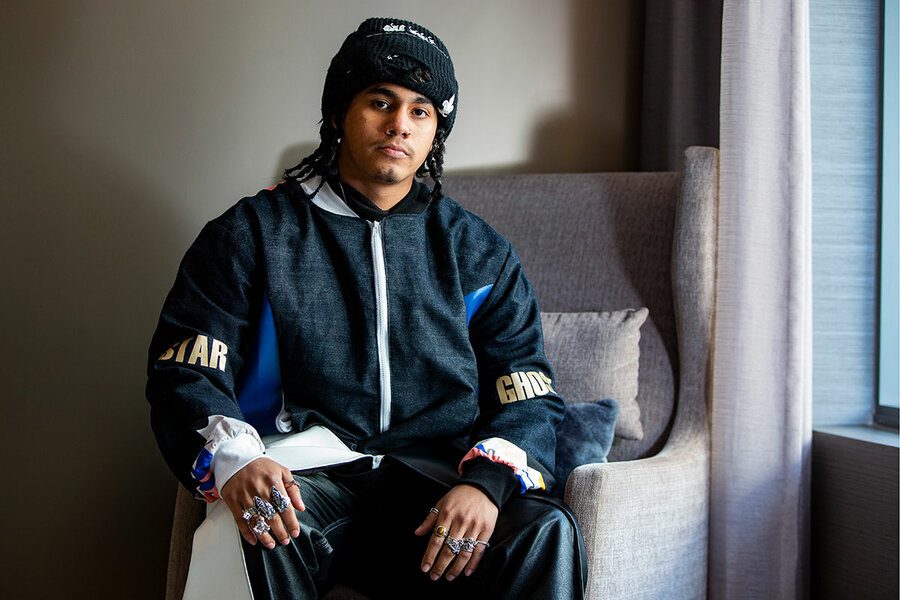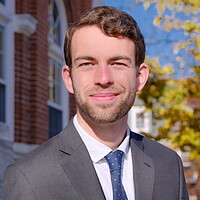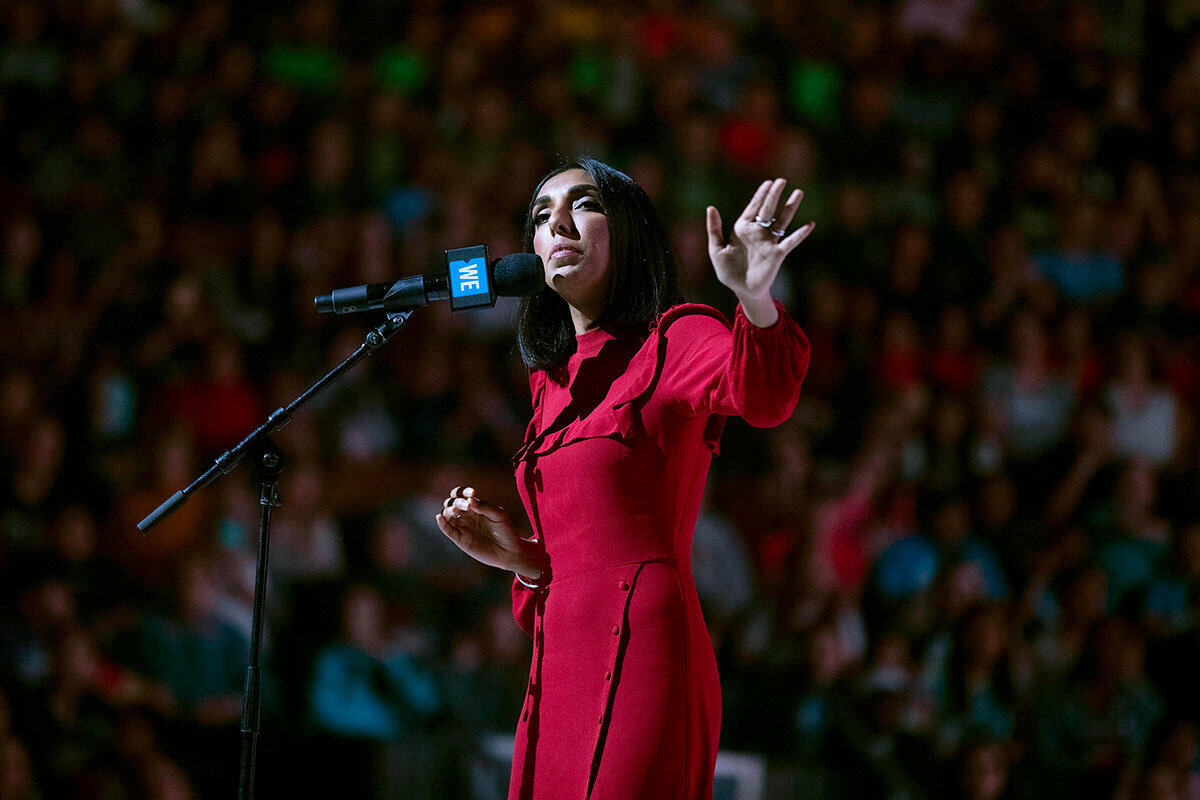New voices in poetry: Thank lockdowns and social media
Loading...
| WORCESTER, MASS.
Adael Mejia strides into the lobby of the hotel where he’ll be performing that night wearing a multicolored overcoat made of recycled clothes that goes nearly to his ankles and a ski mask.
He’s a poet. But he’s also a revolutionary.
Mr. Mejia, the 19-year-old youth poet laureate of Worcester, Massachusetts, is helping to lead an artistic revival, or revolution, as he puts it, in his postindustrial hometown of 200,000.
Why We Wrote This
While people around the world were bound by pandemic lockdowns, their thoughts and emotions found release online. Social media poetry has invited new voices to connect with new audiences, giving the art form new life.
He also represents another revolution – one taking place in the world of poetry. The art form young people often associate with dry high school lessons on Emily Dickinson and Robert Frost is becoming more direct and diverse, in both its creators and its influences, and it is, perhaps most saliently, primarily shared and shaped by social media.
“If it wasn’t for social media – if it wasn’t for being able to post myself and people being able to find out about me through their phone – I would be performing to my mom still,” Mr. Mejia says.
Social media has transformed the way millennials and Generation Z discover, consume, and write poetry. Thanks to platforms like YouTube, Instagram, and TikTok, poetry is now more accessible and more ubiquitous than ever, and it’s driving a resurgence in poetry’s popularity, eliminating barriers to entry for young poets, and changing the art form itself.
“It’s highly shareable,” says Jennifer Benka, president of the Academy of American Poets. “It’s a very accessible art form that has been absolutely aided by the increasing availability of digital devices, and technology, and social media.”
Twelve percent of American adults reported in a National Endowment for the Arts survey that they had read poetry in 2017, the last time the survey was given. That was a 5 point increase from 2012 when poetry readership hit a low of about 7%.
The increase was even more marked among youth 18 to 24 years old, more than doubling from 8.2% to 17.5% between 2012 and 2017.
There’s evidence that trend continued during the pandemic.
Visits to the free poetry website poets.org, maintained by the Academy of American Poets, went up 30% in 2020 as the pandemic began, and traffic remains high, Ms. Benka says.
“This has been, particularly the first year of the pandemic, a time of overwhelming grief and loss and loneliness, and a lot of people wanting to make sense of what was happening in the world,” she says.
Then came Amanda Gorman’s showstopping performance at the 2021 inauguration of President Joe Biden. Eventbrite reported that the number of poetry events registered on the online invitation site leaped 24% in the weeks following the inauguration performance. That figure has increased an additional 26% in the past year, an Eventbrite spokeswoman told the Monitor.
Social media, among other factors, has revived poetry so much that Ms. Benka describes the present moment as “American poetry’s heyday.”
Poetry gained widespread attention on social media in 2013 and 2014 with the success of Indian Canadian artist Rupi Kaur. Ms. Kaur, who was at the time in her early 20s, would publish brief poems accompanied by illustrations on her Instagram account, which racked up millions of likes. In 2014, an established publisher released a collection of her poems, “Milk and Honey,” which sold more than 2.5 million copies.
Donovan Beck also found his audience online.
At age 22 and still a student at California State University, Northridge, Mr. Beck has nearly 440,000 followers on TikTok and an additional 28,000 followers on Instagram.
His poetry, which he performs looking straight into the camera under warm lighting, focuses on mental health, loneliness, and hope, often offering affirmation and optimism.
Mr. Beck came to the art form in high school, when he discovered poets like Andrea Gibson and Rudy Francisco on YouTube and began to write his own. During the pandemic, a friend convinced him to start performing on TikTok, and his account took off.
“I feel like TikTok does open up doors for people to go look,” says Laryssa Lopes, a senior at Southeastern Vocational Technical High School in South Easton, Massachusetts. Since a class project sparked her interest in poetry last year, she’s been watching more and more poetry videos on the platform.
Sometimes she’ll even look up a poet she sees on TikTok or watch longer performances on YouTube – something she’d never be doing without social media. “It does open your eyes.”
While social media has dramatically increased readers’ access to established poets, it’s also knocked down barriers for aspiring ones.
“There’s a little red button on TikTok and a little red button on Instagram in order to record your piece and go share it. And if that’s the only barrier that stops you, that’s good,” Mr. Beck says.
Social media allows poets to skirt traditional gatekeeping institutions like publishing houses and literary magazines, Mr. Beck says, “allowing Black writers and minority group writers to share their stories in ways that would have never been possible.”
The low barrier for publishing, combined with the parameters for posting on each platform, is changing the shape of poetry, with new voices sharing forthright prose. Black and immigrant poets in particular, whose work may not have been heard without social media, grapple with tough issues like identity and justice through stanzas and verse.
That’s what’s attracting readers like Tricia Barros, another senior at Southeastern.
“I always thought about [poetry] as boring,” she said. Then her teacher showed them videos online of slam poets speaking about being Black, like her, and she realized poetry was anything but boring. Now, she writes her own.
But the platforms that welcome new audiences can also invite a barrage of criticism. Much of the poetry originating on social media is short and simple. Poets like Ms. Kaur have faced ridicule for the plain verse.
“People have debates about – is it poetry? Is this not poetry?” says poet Jingming “Mimi” Yu, a student at the University of Nebraska, Lincoln – and Nebraska’s first youth poet laureate. “Social media has made art way more accessible than it used to be and kind of forced us to redefine what a poem is.”
Coming of age principally on Instagram and TikTok where endless streams of content compete for attention, “we don’t have the time to make [a] super large metaphor that has to be dissected to be understood,” Mr. Beck says. “So we just say what we need to say, and the audiences connect with that.”
Mr. Mejia certainly knows how to connect with an audience. On a Friday night this spring, he’s performing at a gala for an arts center in Worcester. His performance is intense, beginning with him circling the stage and ending with him atop a chair, arms outstretched.
The poem he recites is about the struggles and challenges of a young artist who goes from homelessness to the heights of fame.
Though this performance is in person, just in the shadows offstage a man holds up a smartphone. Mr. Mejia’s poetry was being streamed live.







